INN Index 2018
INN’s first Index report, published in October 2018, was the first comprehensive study of the nonprofit, digital media sector.
The INN Index 2018 is based on 2017 data from nearly 60 percent of the INN membership across the United States. It found that opportunities for greater growth among news nonprofits include diversifying revenue sources, investing in business development and targeting audiences.
DOWNLOAD THE 2018 REPORT
Below is the executive summary of the report. If you wish to read the Executive Summary as a PDF, download it here.
Foreword: The growth of nonprofit news is a silver lining story.
Until 10 years ago, nonprofit news was generally mentioned as a footnote on the tax status of a few dozen investigative news outlets. Today, the U.S. has more than 200 nonprofit newsrooms and growth is accelerating. Through a decade of economic turmoil, a new kind of journalism has emerged.
From neighborhoods that want reliable local news to readers seeking expert coverage of complex national issues, Americans increasingly find some of their most significant journalism coming from nonprofit newsrooms.
This INN Index report offers the most comprehensive look so far at the state of nonprofit news. It is intended to be a replicable baseline study that can provide the sector with consistent, regular data. Our aim is to help nonprofit news leaders benchmark their performance, surface trends and speed adoption of successful approaches to supporting news. This report provides an overview of the findings. It is just a beginning, and we hope this data will lead to further research and be a resource for many who support and study media development.
Development of the INN Index was generously supported by the Democracy Fund and is a project of the Institute for Nonprofit News, a network supporting more than 180 nonprofit, nonpartisan newsrooms. Nonprofit news today covers many types of journalism, characterized by original, expert reporting and a mission to serve the public good.
Despite relatively small size, these mission-driven newsrooms are beacons of quality journalism. In the prestigious Online Journalism Awards, half of the 2018 news finalists came from nonprofit newsrooms, a stunning share for a sliver of the media industry. They increasingly win public support as well. In just one year-end fundraising campaign, NewsMatch 2017, the public donated $33 million to support nonprofit journalism, much of that from first-time supporters.
We are grateful for the generous time and openness of the 88 newsrooms that participated in the 2018 INN Index study. Through the information they share, we can strengthen the vital role their journalism plays in our democracy.

Sue Cross
INN Executive Director & CEO
EXECUTIVE SUMMARY
No longer a novelty, nonprofit news has established itself over the past decade as a fast-growing field within journalism, producing original and in-depth reporting, according to the most comprehensive collection yet of data about its scope and composition.
The more than 180 members of the Institute for Nonprofit News have a total estimated staff of about 3,000 – including nearly 2,200 journalists – and combined annual revenue approaching $350 million.
They share with legacy media knotty challenges around audience development, distribution and finding new sources of revenue to support their reporting. But the field is starting to develop multiple sources of funding and diverse revenue strategies to fit the range in their missions and the types of communities they serve.
This INN Index is based on in-depth surveys of 88 news organizations and data from the full INN membership. All are 501(c)3 nonprofits whose primary mission is journalism, which can be characterized by their focus on original reporting and commitment to standards of editorial independence and transparency.
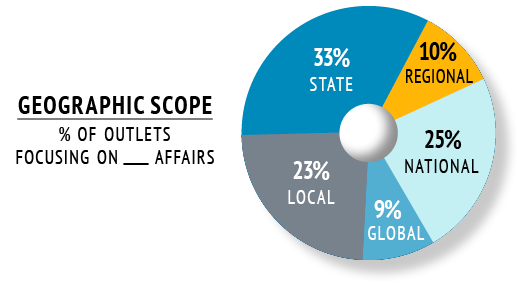
Among key findings:
Nonprofits focus on original reporting and deep coverage of civic issues
In-depth coverage of public affairs is a hallmark of the field: Forty percent of the in- depth coverage of public affairs is a hallmark of the field: Forty percent of the nonprofits are primarily investigative, and one in four regard their main mission as analysis and explanatory journalism.
They focus on topics in the public interest. About two-thirds cover government. Two-thirds cover the environment, and well over half cover education or social justice and inequality.
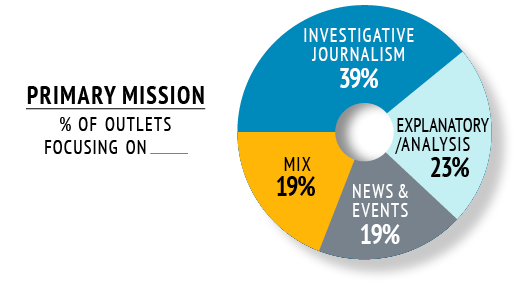
Single-subject news is one of the fastest-growing categories in nonprofit media: publications where specialized journalists cover a single topic, in-depth. A third of news nonprofits focus on a single subject such as health, education, environment or justice.
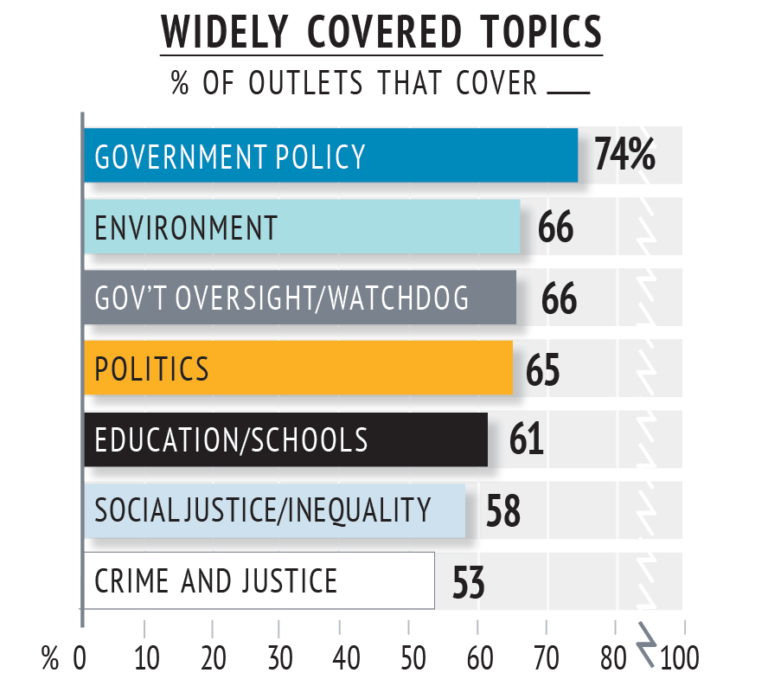
While tiny by the standards of legacy news companies, the nonprofit sector generates an outsize amount of original journalism and the types of reporting that require significant investments of time and expertise. In a troubled news environment marked by cutbacks at traditional outlets, information vacuums, and the rise of misinformation disguised as news, the nonprofits are providing original and in-depth reporting to many other media as well as directly to the public.
The revenue terrain is improving and stabilizing
The field has moved from precarious financial footing to a measure of stability and growth. Though many individual outlets remain financially fragile, more than half of the organizations generated revenues of $500,000 or more in fiscal year 2017 and well over a third generated $1 million or more. The entire INN membership is now generating an estimated $325 million to $350 million in annual revenue.
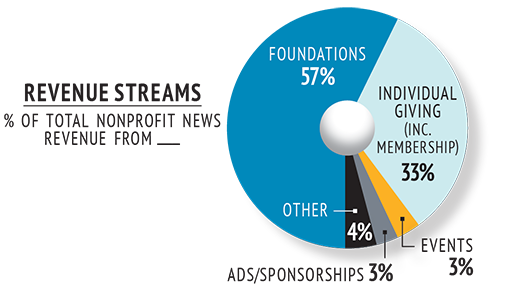
That is a much stronger position than in 2015, when INN found that slightly fewer than a third of its members topped the half-million mark, and the largest share, four in 10,were in the $100,000-$500,000 range.
In 2015, nearly a third were under $100,000; in the latest survey, fewer than one in 10 reported annual revenue at that level.
The nonprofit field is still highly reliant on charitable giving, with grants and donations accounting for 90 percent of total revenue. Efforts to diversify revenue streams, a key indicator of financial stability, are evident: More than half have three or more revenue streams, and one-third have four or more.

Still, individual donors and particularly major donors are relatively undeveloped revenue sources for news nonprofits, making up one third of total revenue for the organizations in the INN Index. By comparison, individual donors provide more than 70 percent of revenue for all nonprofits across the U.S., according to Giving USA.
Earned revenue efforts also are nascent and show significant room for growth. With just 10 percent of revenue from fees and services on average, most news nonprofits lag the leaders in their own field and the charitable world overall in developing earned revenue streams.
In a young field, age matters
The field is dominated by outlets that launched in the past decade amid major cutbacks by traditional news organizations. Three-quarters of the nonprofit news organizations launched since 2008. The typical outlet is 8 years old.
Time is a key factor: More mature organizations stand out for their higher revenue and greater reach online. But some young organizations now start out seeking multiple revenue streams, an approach that may prove advantageous as they mature.
Lean operations invest heavily in editorial
Nonprofit news outlets are lean operations that pour nearly two-thirds of their resources into editorial operations, their core mission.
However, they devote less than one-tenth of their budgets to revenue development. That represents an underinvestment by a young field that is working to establish itself, grow and diversify revenue sources.
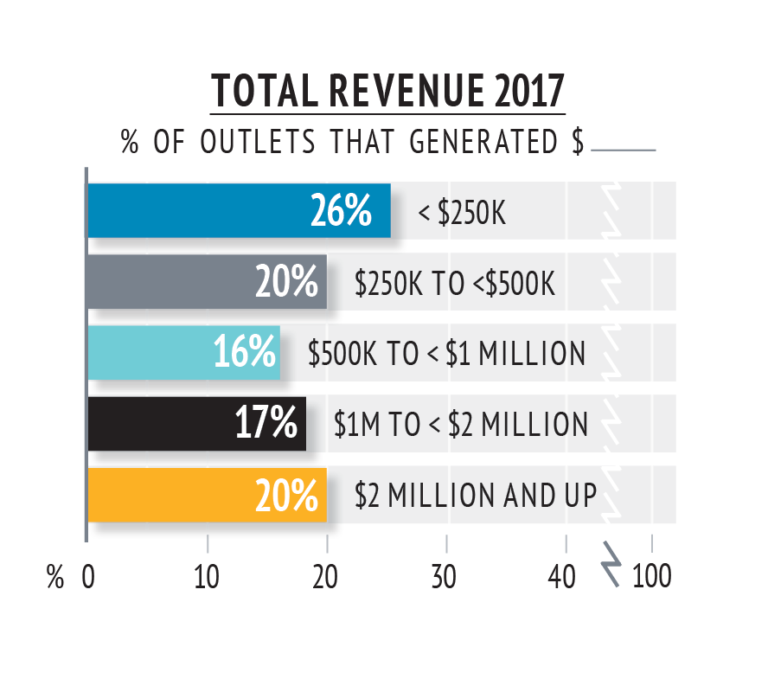
The spending patterns are within normal or recommended benchmarks for nonprofits overall — to win Charity Navigator’s top financial fitness ranking, a nonprofit must attest that it doesn’t spend more than 10 percent of its budget on fundraising, for example.
However, the INN Index shows that maturity brings more aggressive investment in revenue generation: News outlets that are at least a decade old invest more than startups in building revenue, 15 percent or about double what startups spend in their first two years of operation.
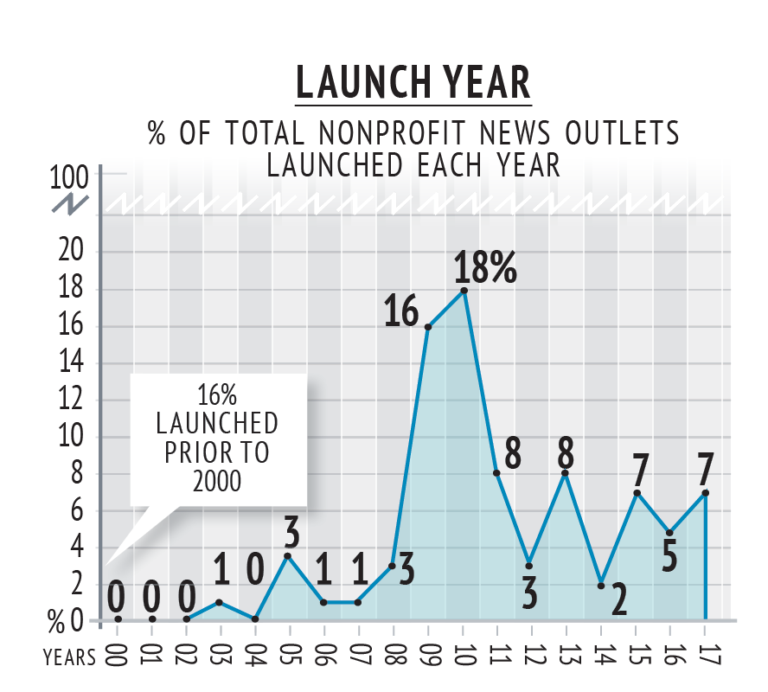
Shifting resources to development is a challenge: Half of all news nonprofits have eight or fewer full-time equivalent employees. Independent contractors make up nearly a third of the labor force, which stands at an estimated 2,900 to 3,000 full-time employees across all INN member outlets.
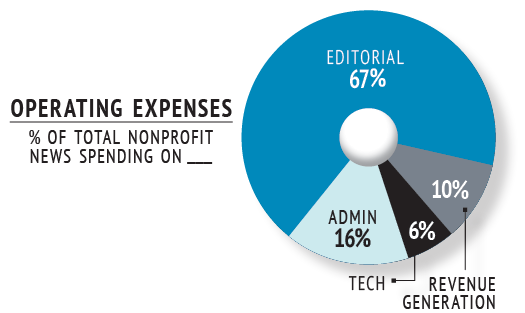
Audience development poses a challenge
The nonprofits as a group face a dilemma: Do they rely on other publications to distribute their work or build a direct web audience from scratch? The answer may be to do both, and experimentation is likely to continue as media distribution patterns continue to shift.
About one-third reach most of their audience on third-party platforms such as newspapers, broadcast outlets or other online news organizations. Another third have developed their own audiences; they reach most of their readers directly via their own website. The remaining third fall somewhere in between or are pursuing both strategies.
As traditional media continue to lose audience and value as distribution partners, many publishers are looking to increase their direct connection with audiences and distance themselves from the turmoil in social media. As it is, the audience that comes directly to their websites is relatively small: Web traffic for the typical nonprofit newsroom is under 500,000 users per year. Email newsletters also are an area for growth, both as news products and a way to reach and develop financial supporters.
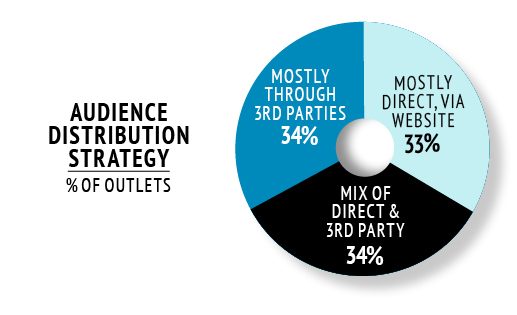
CONCLUSION
Nonprofit journalism is securing its place and helping create a new ecosystem for news while serving a critical role in American civic life.
News nonprofits are setting a strong course toward community engagement and collaboration. They deploy a substantial body of experienced, expert journalists at a time when other media are cutting back, and the nonprofits increasingly fill gaps in public information. They are starting to diversify the revenue streams that support this important reporting.
At the same time, the INN Index points to areas where the field can grow:
Doing more to nourish individual giving, from both small and major donors. Growing these revenue streams is not just good for sustainability, but also builds stronger ties between publishers and the people they serve. With plenty of programs, case studies and research about building and sustaining reader revenue and membership programs, publishers can draw upon the wisdom surrounding them and apply it to their own unique circumstances.
Investing more in business development. The data suggest that startups should not wait to add revenue-building positions, but invest in them early, and dedicate more than 10 percent of expenses to revenue generation. Journalism funders also could increase the impact of their philanthropy by making leveraged investments in news business development positions within the organizations they support.
Building more targeted audiences. Acquiring and growing broad or general audiences is complicated and costly for any media. For small publishers, it can spread staff and resources thin. Alternatively, more nonprofit newsrooms might move faster by building a base in a narrower specialized audience and then broadening from that to a general public readership, or building one niche or neighborhood base at a time, adding another as they grow.
For the many nonprofits that share their content, distribution beyond traditional media needs to be developed as legacy media audiences keep declining.
There are many other threads yet to be followed from this data, and trends that will surface as this survey continues in future years.
The good news is that the field is evolving and quickly growing as a significant source of original, in-depth journalism. These newsrooms have created a collective incubator for the future of public service journalism, finding new ways to share knowledge, include and engage people in civic life and strengthen our communities.
About the survey
The survey of members of the Institute for Nonprofit News was conducted online in March- May 2018. A total of 149 INN members were invited to complete the survey. This report reflects responses of 88 participants to an extensive questionnaire that yielded about 200 data points about each publication’s journalistic mission, revenue performance, budgeting, engagement and distribution practices. The responses reflect performance during each publication’s fiscal year ending in 2017. Following the field period, data were cleaned for inconsistencies, missing entries and reporting errors.
The survey sample reflects a 59 percent response rate and is representative of all INN members. It gives a robust picture of the general state of nonprofit news publishers. Because the total current population of U.S. based nonprofit news publishers can be estimated but is not fully documented, these data should not be taken to scientifically represent all U.S. nonprofit news outlets, not all of which belong to INN. A further note about the nature of the population being studied: While some public broadcasters belong to INN, the typical member is digital-born rather than a public radio or television outlet. As such, these findings should not be taken to reflect trends in the broader world of all public media.
The survey is the first phase of the INN Index initiative, which will track progress and trends in the field with periodic surveys and will enable INN members to compare their performance to that of similar publications.

INN Index Participants
INN expresses its gratitude to all who participated in the INN Index:
Adirondack Explorer
Alhambra Source
Anthropocene Magazine
Arizona CIR
Aspen Journalism
Austin Bulldog
BenitoLink
Better Government Association
Birmingham Watch
Borderzine
Bridge Magazine
CALmatters
Carolina Public Press
Center for Public Integrity
Center for Responsive Politics
Center for Sustainable Journalism
Chalkbeat
Charlottesville Tomorrow
City Bureau
City Limits
CivicStory – NJ Arts News
Coda Media
Connecticut Health I-Team
Current
East Lansing Info (ELi)
ecoRI News
EdSource
Energy News Network
Ensia
FairWarning
FERN
Georgia News Lab
Grist
High Country News
Highlands Current Inc.
Honolulu Civil Beat
inewsource
Injustice Watch
ICIJ
InvestigateWest
Investigative Reporting Workshop
Iowa Watch
KYCIR
Maryland Matters
MarylandReporter.com
Migratory Notes
Milwaukee Neighborhood News
MinnPost
Mississippi Today
Mongabay Corporation
MuckRock
National Institute on Money in State Politics
New England CIR
New Haven Independent
NextCity
NJ Spotlight
Oklahoma Watch
Phil. Public School Notebook
ProPublica
PublicSource
Pulitzer Ctr on Crisis Reporting
Reveal/CIR
Rocky Mountain PBS
Rivard Report
Scalawag
Searchlight New Mexico
Solitary Watch
Solutions Journalism Network
The Chronicle of Social Change
The Colorado Independent
The Connecticut Mirror
The Hechinger Report
The Hummel Report
The Lens
The Midwest CIR
The Mountain Independent
The Nevada Independent
The Seattle Globalist
The Texas Tribune
The Trace
The War Horse
VTDigger
Voice of OC
Voice of San Diego
Wausau Pilot and Review
Wisconsin Watch
WyoFile
Youth Radio
About INN
The Institute for Nonprofit News is a network of more than 180 nonprofit, nonpartisan news media, together strengthening the sources of trusted information for thousands of diverse communities. INN was founded in 2009 to foster a new collective of newsrooms serving the public interest. Today it functions as an innovation network, helping members develop new ways to support journalism and engage communities, providing business, technology and leadership support and a framework for collaboration. INN’s work helps newsrooms bring investigative and civic news to more people, hold the powerful accountable and strengthen democracy.
Report Credits
Authors: Michele McLellan, Jesse Holcomb
Producer: Jules Shapiro
Editor: Howard Goldberg
Graphic designer: Michelle D. Wise
